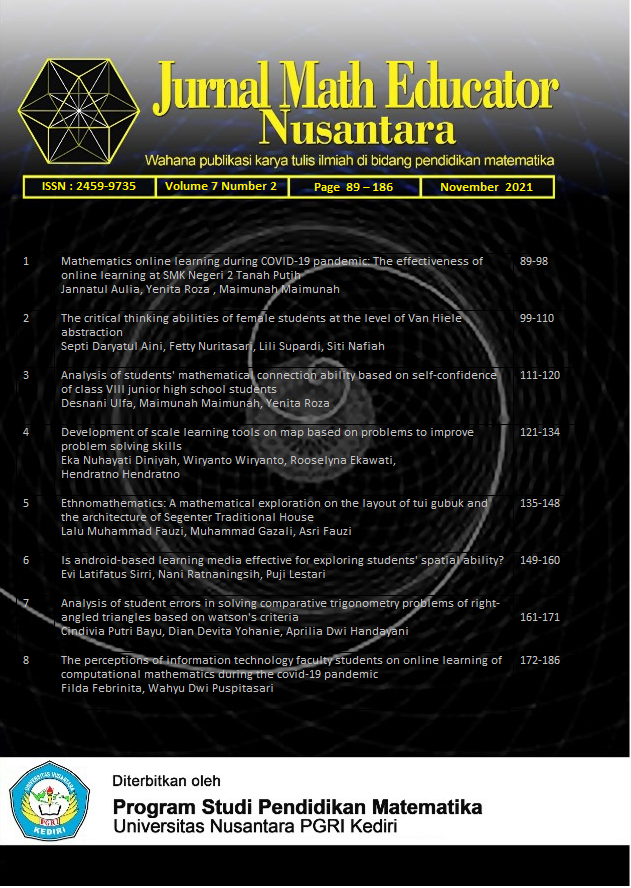Analysis of student errors in solving comparative trigonometry problems of right-angled triangles based on watson's criteria
DOI:
https://doi.org/10.29407/jmen.v7i2.16247Keywords:
Error analysis, trigonometric comparisons, Watson criteriaAbstract
This study aims to analyze the location of students' errors in problem solving and the causal factors based on Watson's criteria. This type of qualitative descriptive research, with the subject of three students of class X AKL 1 taken based on certain considerations according to the criteria or can be called purposive sampling technique. Data collection techniques include direct observation in schools, interviews with subjects and documentation. Triangulation techniques used for data analysis include data reduction, presentation and conclusion drawing. From the results of the analysis, it was found that four types of errors were located inimproper procedures, indirect manipulation, missing data and missing conclusions. The cause of the error is students lack understanding of material concepts, being careless in reading questions, forgetting formulas, being in a hurry, and new factors are found, namely students use other paper to write down the completion steps. The results of the study can explain in detail the errors made by students in solving problems, so that it can minimize the occurrence of similar errors and improve the learning process of mathematics.
References
Aisyah, F. N. K., Hariyani, S., & Dinullah, R. N. I. (2019). Analisis Kesalahan Penyelesaian Soal Cerita Berdasarkan Kriteria Watson. Jurnal Review Pembelajaran Matematika, 4(1).
Aly, B. F. N., Sujadi, A., & Taufiq, I. (2019). Analisis Kesalahan dalam Menyelesaikan Soal Matematika pada Siswa Kelas X SMK Negeri 1 Seyegan. UNION : Jurnal Ilmiah Pendidikan Matematika, 7(1), 135–144. Retrieved from https://doi.org/10.30738/union.v7i1.4050
Anjeli, R., & Irwan. (2019). Analisis Kesalahan Peserta Didik dalam Menyelesaikan Soal Cerita Berdasarkan Kriteria Watson. Jurnal Edukasi Dan Penelitian Matematika, 8(1), 103–109. Retrieved from http://ejournal.unp.ac.id/students/index.php/pmat/article/view/6245
Ayarsha, R. (2016). Analisis Kesalahan Siswa dalam Mengerjakan Soal Matematika Berdasarkan Kriteria Watson. Universitas Islam Negeri Syarif Hidayatullah.
Cahyani, A., & Aini, I. N. (2021). Analisis Kesalahan Siswa dalam Menyelesaikan Soal Trigonometri Berdasarkan Kriteria Watson. Jurnal Pembelajaran Matematika Inovatif, 4(2), 365–372. https://doi.org/10.22460/jpmi.v4i2.365-372
Csáky, A., Szabová, E., & Naštická, Z. (2015). Analysis of Errors in Student Solutions of Context-Based Mathematical Tasks. Acta Mathematica Nitriensia, 1(1), 68–75. https://doi.org/10.17846/amn.2015.1.1.68-75
Dazrullisa, & Hadi, K. (2021). Analisis Kesalahan Siswa dalam Menyelesaikan Soal Matematika Berdasarkan Kriteria Watson. GENTA MULIA : Jurnal Ilmiah Pendidikan, 12(2).
El-khateeb, M. M. A. (2016). Errors Analysis of Solving Linear Inequalities among the Preparatory Year Students at King Saud University . Journal of Education and Practice, 7(12), 124–133. Retrieved from www.iiste.org
Hawa, S. (2020). Generasi Hebat Generasi Matematika. Pekalongan: PT. Nasya Expanding Management.
Helaluddin, & Wijaya, H. (2019). Analisis Data Kualitatif; Sebuah Tinjauan Teori & Praktik (Pertama). Makassar: Sekolah Tinggi Theologia Jaffray.
Jatisunda, M. G., & Nahdi, D. S. (2019). Kesulitan Siswa dalam Memahami Konsep Trigonometri di Lihat dari Learning Obstacles. Jurnal Didactical Mathematics, 2(1), 9–16.
Khotimah, K., Yuwono, I., & Rahardjo, S. (2016). Kesulitan Siswa dalam Menyelesaikan Soal Perbandingan Trigonometri. Prosiding Seminar Nasional Pendidikan Matematika, 1, 46–52.
Maryani, A., & Chotimah, S. (2021). Analisis Kesalahan dalam Menyelesaikan Soal Barisan dan Deret Berdasarkan Kategori Watson. Jurnal Cendekia: Jurnal Pendidikan Matematika, 5(3), 2344–2351. https://doi.org/10.31943/gemawiralodra.v10i2.81
Najib, A. (2019). Analisis Kesalahan Pemahaman dalam Materi Segiempat Menurut Tingkat Berpikir Van Hiele pada Siswa SMP Negeri 1 Suppa Kabupaten Pinrang. AKSIOMATIK : Jurnal Ilmiah Matematika Dan Pembelajarannya, 6(1).
Novianti, V., & Riajanto, M. L. E. J. (2021). Analisis Kesulitan Siswa SMK dalam Menyelesaikan Soal Materi Trigonometri. Jurnal Pembelajaran Matematika Inovatif, 4(1), 161–168. https://doi.org/10.22460/jpmi.v4i1.161-168
Palayukan, H., & Pelix, L. (2018). Analisis Kesalahan Siswa dalam Menyelesaikan Soal Perbandingan Trigonometri pada Segitiga Siku-Siku Berdasarkan Kriteria Watson di Kelas X SMA Katolik Rantepao. Inspiramatika, 4(1), 47–60.
Rachman, A. F. (2020). Analisis Kesalahan Siswa Kelas XI pada Materi Trigonometri. Jurnal Cendekia : Jurnal Pendidikan Matematika, 04(01), 126–133.
Santoso, T., Cholily, Y. M., & Syaifuddin, M. (2021). An Analysis of Students’ Errors in Completing Essay HOTS Questions Based On Watson’s Criteria Viewed From The Cognitive Style Perspective. JTAM (Jurnal Teori Dan Aplikasi Matematika), 5(1), 121–133. https://doi.org/10.31764/jtam.v5i1.3776
Sanwidi, A. (2018). Analisis Kesalahan Mahasiswa Matematika UNU Blitar dalam Menyelesaikan Soal Matematika Materi Fungsi Berdasarkan Kriteria Watson. BRILIANT : Jurnal Riset Dan Konseptual, 3(1).
Saputri, R. R., Sugiarti, T., Murtikusuma, R. P., Trapsilasiwi, D., & Yudianto, E. (2018). Analisis Kesalahan Siswa dalam Menyelesaikan Soal Materi Fungsi Berdasarkan Kriteria Watson Ditinjau dari Perbedaan Gender Siswa SMP Kelas VIII. Jurnal Kadikma, 9(2), 59–61. Retrieved from https://jurnal.unej.ac.id/index.php/kadikma/article/view/9710
Siyoto, S., & Sodik, A. (2015). Dasar Metodologi Penelitian (1st ed.). Yogyakarta: Literasi Media Publishing.
Sugiyono. (2009). Metode Penelitian Kuantitatif, Kualitatif, dan RAD. Bandung: Alfabeta.
Widodo, Y. S. (2017). Analisis Kesalahan Siswa dalam Menyelesaikan Masalah Trigonometri Berdasarkan Dimensi Pengetahuan Anderson Pada Siswa Kelas XI SMKP Hang Tuah Kediri.
Wulandari, S., & Gusteti, M. U. (2020). Analisis Kesalahan Menyelesaikan Soal Trigonometri Siswa Kelas X SMA. Math Educa Journal, 4(1), 64–80.
Wulandari, V. A. (2016). Analisis Kesalahan dalam Memecahkan Masalah Open Ended Berdasarkan Kategori Kesalahan Menurut Watson pada Materi Pecahan Siswa Kelas VII SMP Negeri 4 Jember. Universitas Jember.
Downloads
Published
Issue
Section
License
Authors who publish with this journal agree to the following terms:
- Copyright on any article is retained by the author(s).
- The author grants the journal, the right of first publication with the work simultaneously licensed under a Creative Commons Attribution License that allows others to share the work with an acknowledgment of the work’s authorship and initial publication in this journal.
- Authors are able to enter into separate, additional contractual arrangements for the non-exclusive distribution of the journal’s published version of the work (e.g., post it to an institutional repository or publish it in a book), with an acknowledgment of its initial publication in this journal.
- Authors are permitted and encouraged to post their work online (e.g., in institutional repositories or on their website) prior to and during the submission process, as it can lead to productive exchanges, as well as earlier and greater citation of published work.
- The article and any associated published material is distributed under the Creative Commons Attribution-ShareAlike 4.0 International License
















